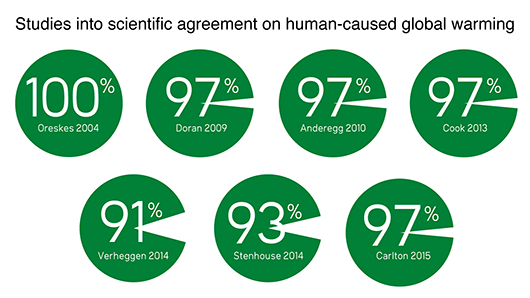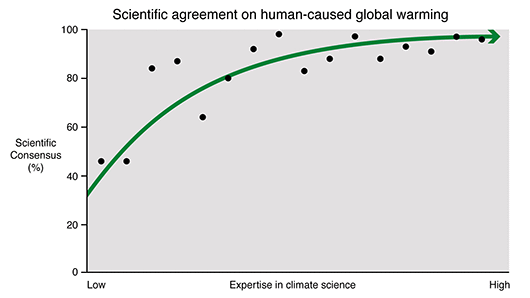
Originally published in Corporate Knights Magazine

In 1998 and 1999, American scientists Michael Mann, Raymond Bradley and Malcolm Hughes published two papers that reconstructed the average temperatures of the northern hemisphere back to the year 1000. The articles showed a temperature profile that gently declined from 1000 to 1850, fluctuating a little along the way, with a sudden increase in the late nineteenth and the twentieth centuries. The graph was nick-named “the Hockey Stick”, with its long relatively straight handle showing the stable pre-industrial climate and the blade representing the sudden uptick in the last 150 years.
The diagram was a striking depiction of the abrupt warming that had occurred since the Industrial Revolution compared to what happened before. For those opposed to the scientific consensus on Anthropogenic Global Warming (AGW), the Hockey Stick posed a threat and had to be broken.
As detailed in Mann’s 2013 book The Hockey Stick and the Climate Wars: Dispatches from the Front Lines,his critics employed a variety of tactics to try to break the hockey stick. They disputed the statistical methods that Mann and his colleagues used, although they never produced new results of their own. Stolen private conversations were quote-mined for damning phrases. Senior US politicians and the right-wing press denounced the work a fraud.
Mann and other scientists were subjected to numerous investigations, all of which exonerated the Hockey Stick authors. Most importantly, other researchers, using alternative methods and new data, produced additional temperature curves that closely matched the original results of Mann et al. Nevertheless, the attacks on the original Hockey Stick continued, as has the harassment of Mann by right-wing pundits. If you need to deny the consensus on AGW, you have to keep repeating that the “Hockey Stick is Broken”. Never mind that it is intact and that there are enough new sticks to equip an NHL team.
There are parallels with the reception given to the paper Quantifying the consensus on anthropogenic global warming in the scientific literature, published in 2013 by University of Queensland researcher John Cook and eight volunteers associated with the website Skeptical Science (including me). The paper, published in the journal Environmental Research Letters (ERL), has been deemed a hoax and a fraud, by contrarian bloggers as well as by Republican presidential hopefuls such as Ted Cruz and Rick Santorum.
The most determined academic critic has been Dr Richard Tol, an econometrician at the University of Sussex. Tol is a prolific and widely-cited author on the economic impact of future climate change and is an advisor to the Global Warming Policy Foundation, a British organization opposed to taking action on climate change. Tol published a critique in 2014 in the journal Energy Policy, which I discussed previously at Corporate Knights.

Tol had made several attempts to publish a critical response in the ERL. After several rejections, the journal finally accepted a comment by Tol this year. Part of his new paper was a rehash of methodological quibbles that had been answered before. He made no estimate of how much these minor issues, even if they were valid, might affect the overall results.
Tol also surveyed the recent literature on consensus studies and claimed that the Cook et al study is an outlier. In an early draft of his article, which he put online before it was accepted by the journal, he grossly mischaracterized the results of several other studies, claiming that they had found low levels of scientific consensus. Dutch blogger Collin Maessen wrote to the authors of those articles and asked them what they thought of Tol’s manuscript. Here are samples of the reactions:
Reactions like these motivated the authors of those studies, from nine different universities in the US, UK and the Netherlands, to join the original volunteer team that worked on the 97 per cent paper in writing a rebuttal to Tol. This effort turned into a short review of several recent consensus research articles. It was published in ERL as an open-access paper on April 13 2016.
Examining fifteen different studies, we found that the results depended strongly on the exact question asked and the level of expertise of the scientists sampled. The more expert the group of scientists whose views were examined, the higher the level of consensus that recent global warming is man-made. Actively publishing climatologists are more in agreement than, for example, economic geologists. Consensus figures ranged from 90 to 100 per cent among the most expert climate scientists, with a clustering of results around 97 per cent: there is nothing exceptional about the Cook et al result.
The concluding sentence of the rebuttal paper reads:
From a broader perspective, it doesn’t matter if the consensus number is 90% or 100%. The level of scientific agreement on AGW is overwhelmingly high because the supporting evidence is overwhelmingly strong.
Although the 2013 Cook et al study has received the most attention, several other independent studies have reached the same general conclusions. There is a consensus that there is a strong consensus that humans are the primary cause of recent global warming.
John Cook has prepared a short video, explaining all of this:
In the wake of the Paris Agreement, in which 195 countries unanimously pledged to cut fossil fuel emissions, readers might well ask why measuring the consensus on AGW matters.
One problem is that the electorate of the United States is not strongly committed to the Paris goals. In particular, the Republican party, which controls both houses of Congress and a majority of state capitols, overwhelmingly denies that humans are a major cause of climate change.
A recent survey of school teachers in the U.S. found that although two-thirds of them accepted a major human role in recent global warming, less than half were aware of the overwhelming consensus among climate scientists. When so many teachers believe that there is a substantial minority of experts who doubt AGW, it is not surprising that they often adopt a “both sides” approach to teaching the subject. This gives a bogus veneer of credibility to anti-AGW views.
It has long been an effective tactic for conservative thought leaders to cast doubt on the scientific consensus of man-made climate change. This has resulted in the so-called “consensus gap”: the mismatch between perceptions of the degree of scientific consensus that exists among teachers and the public at large, and the very strong agreement within the expert community.
Recent research by Sander van der Linden of Princeton University and two colleagues has demonstrated that communicating the true degree of consensus is an effective strategy in influencing opinions across the political spectrum. Indeed, they conclude that public perception of the scientific consensus is an important “gateway belief” that allows people who doubt the reality of man-made climate change to move from rejection to acceptance.
This has also important consequences for policy outside the U.S. In December 2015, the nations of the world agreed unanimously in Paris to an aggressive program to reduce greenhouse gas emissions to limit the increase in global average temperatures to 2 C above pre-industrial levels. However, that target needs to be translated into effective policies at national levels and that will require solid support among electorates who do not understand how solid the underlying scientific consensus is. Unlocking the gateway of doubt is essential if governments are to maintain public support and move from good intentions to success in halting global warming.
The climate change “merchants of doubt” are unlikely to give up peddling spurious uncertainty messages any day soon. Politicians like Ted Cruz will continue to question the temperature record despite the fact that multiple studies have confirmed that the anomalies observed in 2014 and 2015 are the highest since measurements began. The doubters also seem unable to accept that the “Hockey Stick” graphs, which show that post-industrial global warming is unprecedented over the past two millennia, have been independently replicated several times. Although multiple studies demonstrate that the overwhelming majority of climate scientists conclude that this exceptional recent warming is caused by humans, obstinate deniers will continue to insist, against all evidence, that the consensus on climate change is crumbling.
The scientific consensus on climate change is not founded on a single study. Instead, many research projects using independent methods arrive at similar results. It is these multiple lines of evidence that give the scientific community such strong confidence that humans are responsible for the recent unprecedented warming of the surface of the Earth. And it is on this solid bedrock that policy makers have to construct the strategies that will reduce the irreversible changes that we are making to the livability of the only home we have.
Posted by Andy Skuce on Thursday, 5 May, 2016
 |
The Skeptical Science website by Skeptical Science is licensed under a Creative Commons Attribution 3.0 Unported License. |